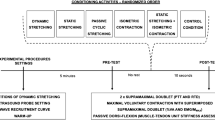Abstract
Electromyographic (EMG) feedback offers a mechanism for helping musicians reduce specific muscle tension during performance. Nine intermediate to advanced level string players participated in a four-session, pretest/posttest design study to determine (1) if left forearm extensor EMG could be reduced using biofeedback, (2) if reductions in EMG would generalize to a no-feedback condition, and (3) if reductions in EMG would generalize from extensors to flexors. Results indicate that biofeedback did facilitate significant decreases in EMG, that the reductions in EMG did generalize to a no-feedback condition, and that generalization from extensors to flexors did not occur.
Similar content being viewed by others
References
Autogenic Systems Inc.Instruction manual for the Autogen 1700. Berkeley, California: Author, 1975.
Basmajian, J. V.Muscles alive. Baltimore: Williams and Wilkins, 1967.
Basmajian, J. V. Electromyography comes of age.Science 1972,176 603–609.
Basmajian, J. V., & Newton, W. J. Feedback training of parts of buccinator muscle in man.Psychophysiology 1974,11 92.
Basmajian, J. V., & White, E. R. Neuromuscular control of trumpeters' lipsNature 1973,241 70.
Evoskevich, P. Biofeedback and its use in treatment of musical performance anxiety.Saxophone Symposium 1979,4 31–32.
French, S. N. Electromyographic biofeedback for tension control during fine motor skill acquisition.Biofeedback and Self-Regulation 1980,5 221–228.
Grossman, W. I., & Weiner, H. Some factors affecting the reliability of surface electromyography.Psychosomatic Medicine 1966,28 78–82.
Levee, J. R., Cohen, M. J., & Rickles, W. H. Electromyographic biofeedback for relief of tension in the facial and throat muscles of a woodwind musician.Biofeedback and Self-Regulation 1976,1 113–120.
Martens, R. Anxiety and motor behavior: A review.Journal of Motor Behavior 1971,3 151–179.
Nideffer, R. M., & Hessler, N. D. Controlling performance anxiety.College Music Symposium 1979,18 146–153.
Siegel, S.Nonparametric statistics for the behavioral sciences. New York: McGraw-Hill, 1956.
White, E. R., & Basmajian, J. V. Electromyography of lip muscles and their role in trumpet playing.Journal of Applied Physiology 1973,35 892–897.
Author information
Authors and Affiliations
Rights and permissions
About this article
Cite this article
Morasky, R.L., Reynolds, C. & Clarke, G. Using biofeedback to reduce left arm extensor EMG of string players during musical performance. Biofeedback and Self-Regulation 6, 565–572 (1981). https://doi.org/10.1007/BF00998740
Issue Date:
DOI: https://doi.org/10.1007/BF00998740




